Case Study: Australian Consumer Law - Negligent Misstatement - 7159AFE
VerifiedAdded on 2023/06/04
|10
|3274
|203
Case Study
AI Summary
This assignment presents a comprehensive case study analysis of an Australian Consumer Law issue, specifically focusing on a scenario involving Bruno and Maria Ferreira, an immigrant couple planning to start a business in Australia. The couple purchased a shop and, during the cooling-off period, discovered plans for a light rail line that could impact their business. They sought information from the Brisbane City Council, which provided incorrect assurances, leading to significant financial losses. The analysis meticulously follows the ILAC (Issue, Law, Application, Conclusion) framework. It identifies the key legal issues, including negligence and negligent misstatement, and cites relevant legislation and case law, such as the Civil Liability Act 2003 (Qld) and the Hedley Byrne & Co v Heller & Partners case. The application section thoroughly applies the law to the facts, demonstrating how the Brisbane City Council owed a duty of care and breached it through misstatement, resulting in economic loss for the couple. The analysis concludes that the couple has a strong case for negligent misstatement and details the potential compensation they can claim. The assignment highlights the importance of accurate information and the consequences of negligence in business transactions, making it an excellent resource for students studying consumer law.
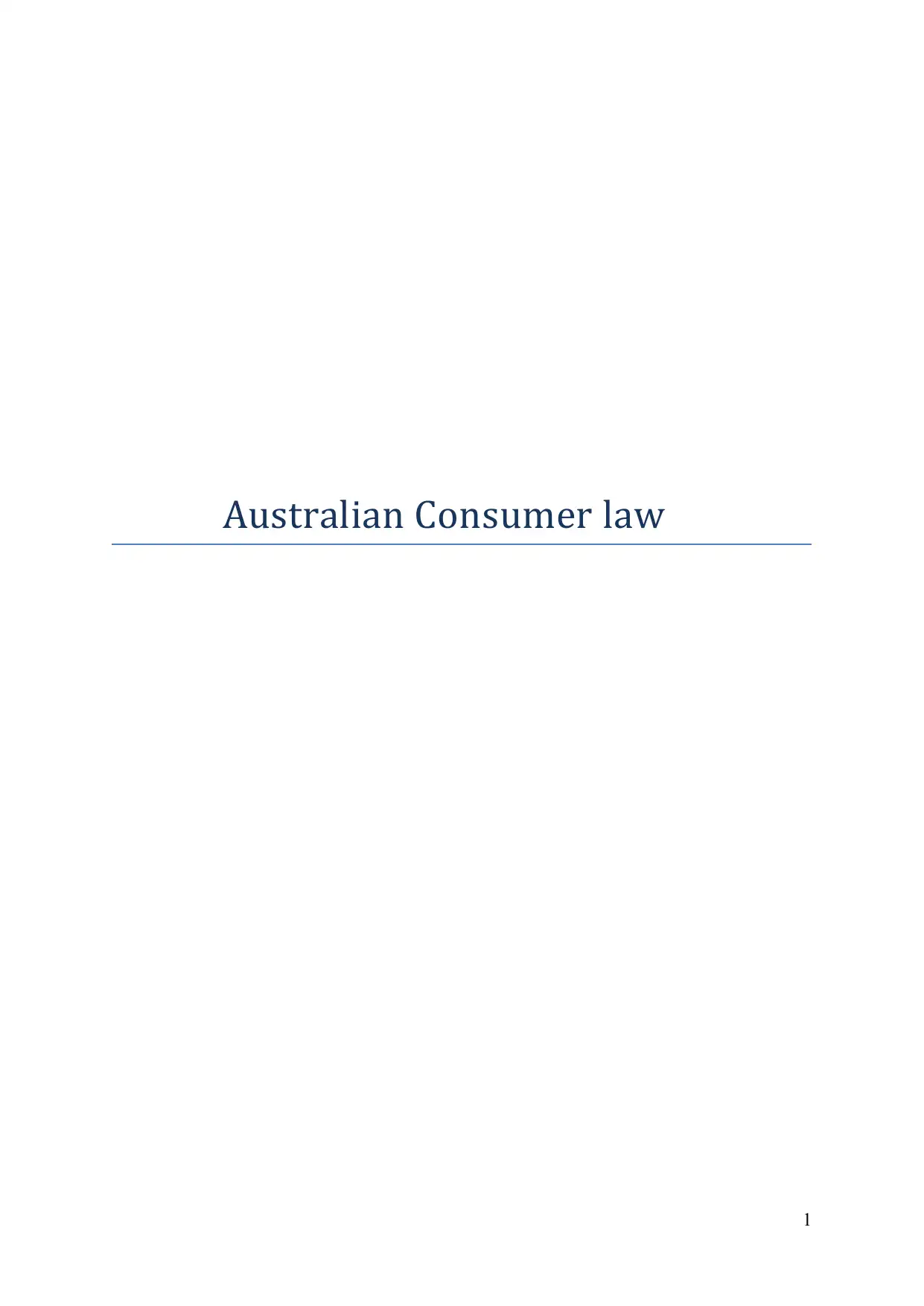
Australian Consumer law
1
1
Secure Best Marks with AI Grader
Need help grading? Try our AI Grader for instant feedback on your assignments.
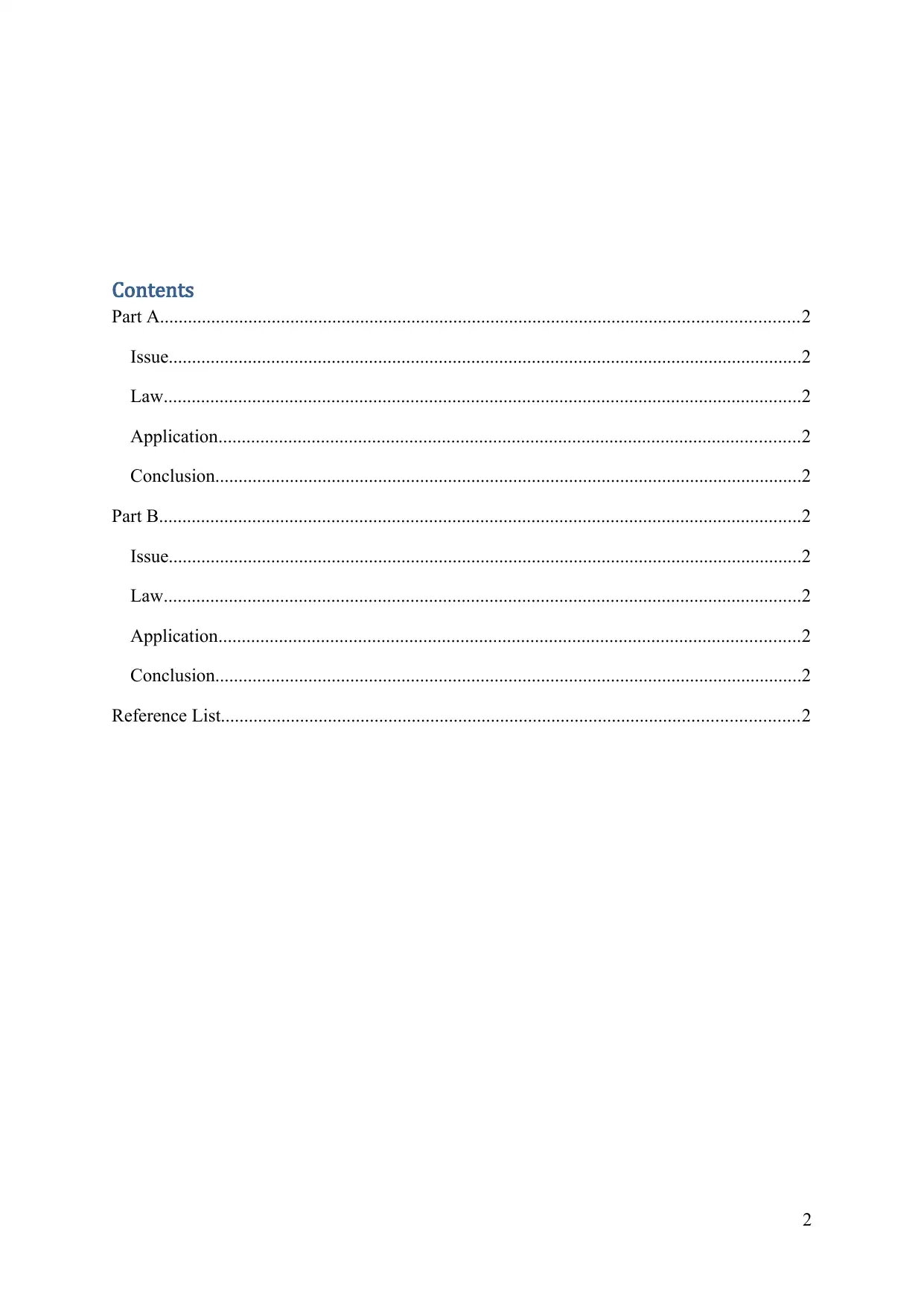
Contents
Part A.........................................................................................................................................2
Issue........................................................................................................................................2
Law.........................................................................................................................................2
Application.............................................................................................................................2
Conclusion..............................................................................................................................2
Part B..........................................................................................................................................2
Issue........................................................................................................................................2
Law.........................................................................................................................................2
Application.............................................................................................................................2
Conclusion..............................................................................................................................2
Reference List............................................................................................................................2
2
Part A.........................................................................................................................................2
Issue........................................................................................................................................2
Law.........................................................................................................................................2
Application.............................................................................................................................2
Conclusion..............................................................................................................................2
Part B..........................................................................................................................................2
Issue........................................................................................................................................2
Law.........................................................................................................................................2
Application.............................................................................................................................2
Conclusion..............................................................................................................................2
Reference List............................................................................................................................2
2
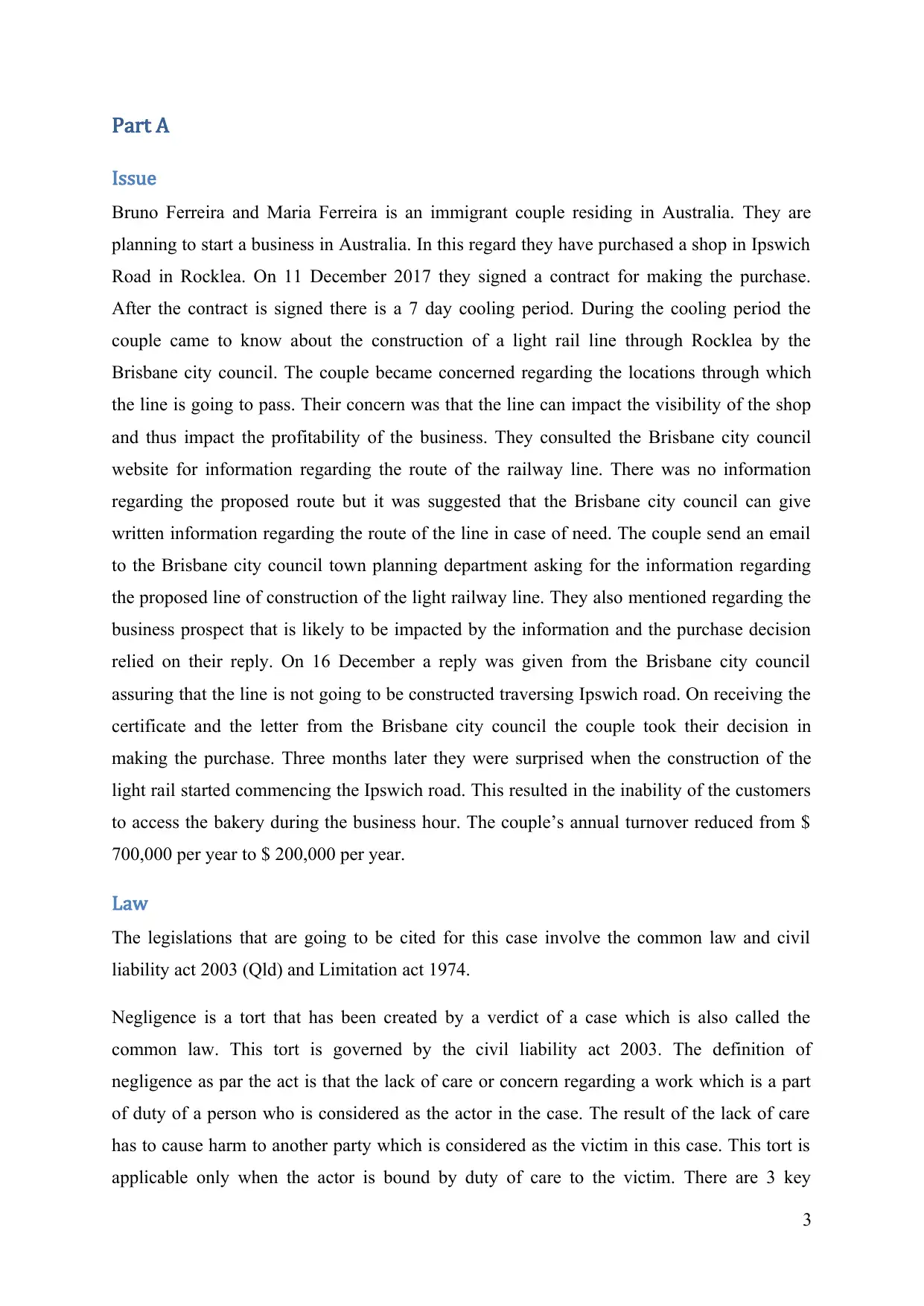
Part A
Issue
Bruno Ferreira and Maria Ferreira is an immigrant couple residing in Australia. They are
planning to start a business in Australia. In this regard they have purchased a shop in Ipswich
Road in Rocklea. On 11 December 2017 they signed a contract for making the purchase.
After the contract is signed there is a 7 day cooling period. During the cooling period the
couple came to know about the construction of a light rail line through Rocklea by the
Brisbane city council. The couple became concerned regarding the locations through which
the line is going to pass. Their concern was that the line can impact the visibility of the shop
and thus impact the profitability of the business. They consulted the Brisbane city council
website for information regarding the route of the railway line. There was no information
regarding the proposed route but it was suggested that the Brisbane city council can give
written information regarding the route of the line in case of need. The couple send an email
to the Brisbane city council town planning department asking for the information regarding
the proposed line of construction of the light railway line. They also mentioned regarding the
business prospect that is likely to be impacted by the information and the purchase decision
relied on their reply. On 16 December a reply was given from the Brisbane city council
assuring that the line is not going to be constructed traversing Ipswich road. On receiving the
certificate and the letter from the Brisbane city council the couple took their decision in
making the purchase. Three months later they were surprised when the construction of the
light rail started commencing the Ipswich road. This resulted in the inability of the customers
to access the bakery during the business hour. The couple’s annual turnover reduced from $
700,000 per year to $ 200,000 per year.
Law
The legislations that are going to be cited for this case involve the common law and civil
liability act 2003 (Qld) and Limitation act 1974.
Negligence is a tort that has been created by a verdict of a case which is also called the
common law. This tort is governed by the civil liability act 2003. The definition of
negligence as par the act is that the lack of care or concern regarding a work which is a part
of duty of a person who is considered as the actor in the case. The result of the lack of care
has to cause harm to another party which is considered as the victim in this case. This tort is
applicable only when the actor is bound by duty of care to the victim. There are 3 key
3
Issue
Bruno Ferreira and Maria Ferreira is an immigrant couple residing in Australia. They are
planning to start a business in Australia. In this regard they have purchased a shop in Ipswich
Road in Rocklea. On 11 December 2017 they signed a contract for making the purchase.
After the contract is signed there is a 7 day cooling period. During the cooling period the
couple came to know about the construction of a light rail line through Rocklea by the
Brisbane city council. The couple became concerned regarding the locations through which
the line is going to pass. Their concern was that the line can impact the visibility of the shop
and thus impact the profitability of the business. They consulted the Brisbane city council
website for information regarding the route of the railway line. There was no information
regarding the proposed route but it was suggested that the Brisbane city council can give
written information regarding the route of the line in case of need. The couple send an email
to the Brisbane city council town planning department asking for the information regarding
the proposed line of construction of the light railway line. They also mentioned regarding the
business prospect that is likely to be impacted by the information and the purchase decision
relied on their reply. On 16 December a reply was given from the Brisbane city council
assuring that the line is not going to be constructed traversing Ipswich road. On receiving the
certificate and the letter from the Brisbane city council the couple took their decision in
making the purchase. Three months later they were surprised when the construction of the
light rail started commencing the Ipswich road. This resulted in the inability of the customers
to access the bakery during the business hour. The couple’s annual turnover reduced from $
700,000 per year to $ 200,000 per year.
Law
The legislations that are going to be cited for this case involve the common law and civil
liability act 2003 (Qld) and Limitation act 1974.
Negligence is a tort that has been created by a verdict of a case which is also called the
common law. This tort is governed by the civil liability act 2003. The definition of
negligence as par the act is that the lack of care or concern regarding a work which is a part
of duty of a person who is considered as the actor in the case. The result of the lack of care
has to cause harm to another party which is considered as the victim in this case. This tort is
applicable only when the actor is bound by duty of care to the victim. There are 3 key
3
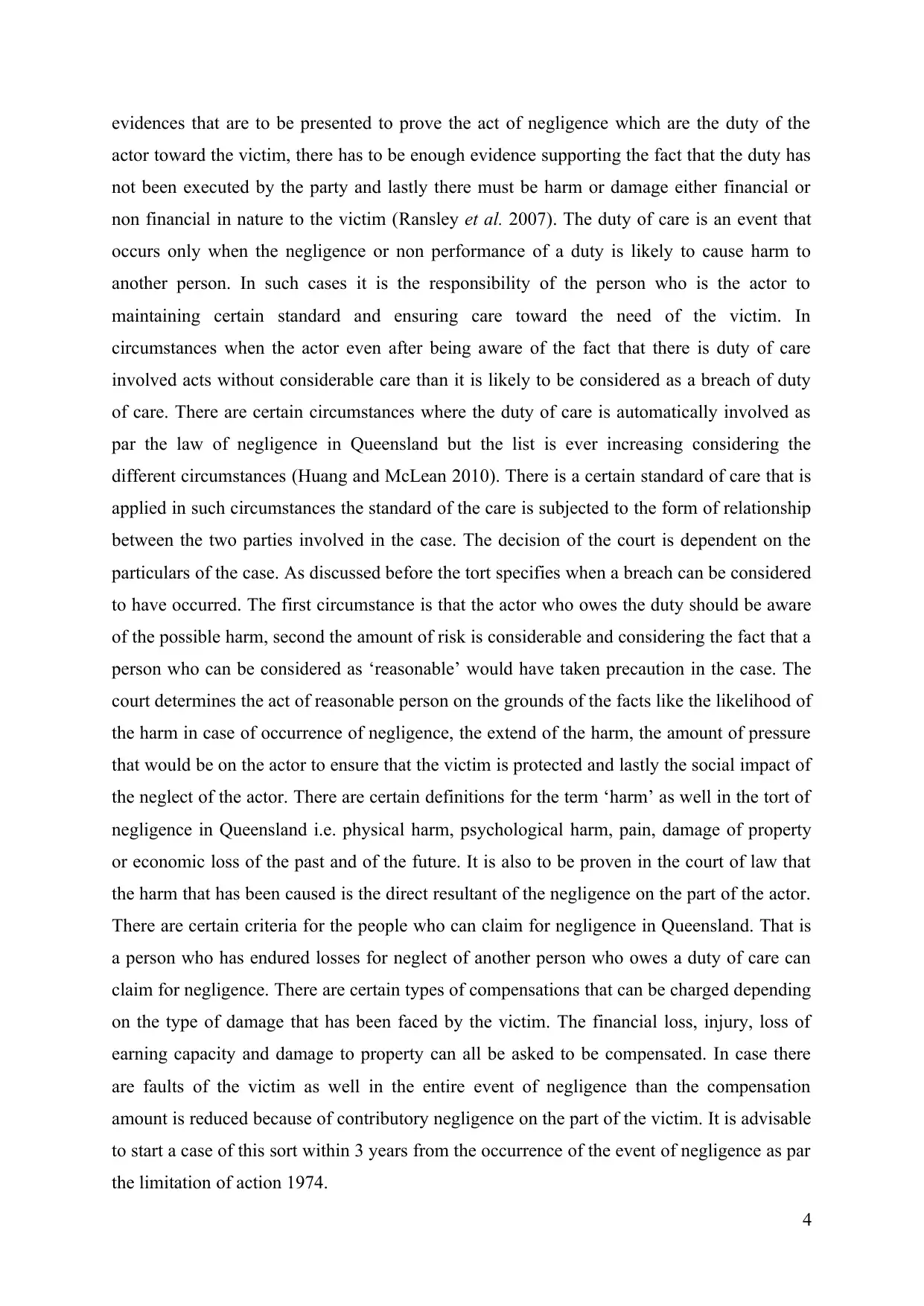
evidences that are to be presented to prove the act of negligence which are the duty of the
actor toward the victim, there has to be enough evidence supporting the fact that the duty has
not been executed by the party and lastly there must be harm or damage either financial or
non financial in nature to the victim (Ransley et al. 2007). The duty of care is an event that
occurs only when the negligence or non performance of a duty is likely to cause harm to
another person. In such cases it is the responsibility of the person who is the actor to
maintaining certain standard and ensuring care toward the need of the victim. In
circumstances when the actor even after being aware of the fact that there is duty of care
involved acts without considerable care than it is likely to be considered as a breach of duty
of care. There are certain circumstances where the duty of care is automatically involved as
par the law of negligence in Queensland but the list is ever increasing considering the
different circumstances (Huang and McLean 2010). There is a certain standard of care that is
applied in such circumstances the standard of the care is subjected to the form of relationship
between the two parties involved in the case. The decision of the court is dependent on the
particulars of the case. As discussed before the tort specifies when a breach can be considered
to have occurred. The first circumstance is that the actor who owes the duty should be aware
of the possible harm, second the amount of risk is considerable and considering the fact that a
person who can be considered as ‘reasonable’ would have taken precaution in the case. The
court determines the act of reasonable person on the grounds of the facts like the likelihood of
the harm in case of occurrence of negligence, the extend of the harm, the amount of pressure
that would be on the actor to ensure that the victim is protected and lastly the social impact of
the neglect of the actor. There are certain definitions for the term ‘harm’ as well in the tort of
negligence in Queensland i.e. physical harm, psychological harm, pain, damage of property
or economic loss of the past and of the future. It is also to be proven in the court of law that
the harm that has been caused is the direct resultant of the negligence on the part of the actor.
There are certain criteria for the people who can claim for negligence in Queensland. That is
a person who has endured losses for neglect of another person who owes a duty of care can
claim for negligence. There are certain types of compensations that can be charged depending
on the type of damage that has been faced by the victim. The financial loss, injury, loss of
earning capacity and damage to property can all be asked to be compensated. In case there
are faults of the victim as well in the entire event of negligence than the compensation
amount is reduced because of contributory negligence on the part of the victim. It is advisable
to start a case of this sort within 3 years from the occurrence of the event of negligence as par
the limitation of action 1974.
4
actor toward the victim, there has to be enough evidence supporting the fact that the duty has
not been executed by the party and lastly there must be harm or damage either financial or
non financial in nature to the victim (Ransley et al. 2007). The duty of care is an event that
occurs only when the negligence or non performance of a duty is likely to cause harm to
another person. In such cases it is the responsibility of the person who is the actor to
maintaining certain standard and ensuring care toward the need of the victim. In
circumstances when the actor even after being aware of the fact that there is duty of care
involved acts without considerable care than it is likely to be considered as a breach of duty
of care. There are certain circumstances where the duty of care is automatically involved as
par the law of negligence in Queensland but the list is ever increasing considering the
different circumstances (Huang and McLean 2010). There is a certain standard of care that is
applied in such circumstances the standard of the care is subjected to the form of relationship
between the two parties involved in the case. The decision of the court is dependent on the
particulars of the case. As discussed before the tort specifies when a breach can be considered
to have occurred. The first circumstance is that the actor who owes the duty should be aware
of the possible harm, second the amount of risk is considerable and considering the fact that a
person who can be considered as ‘reasonable’ would have taken precaution in the case. The
court determines the act of reasonable person on the grounds of the facts like the likelihood of
the harm in case of occurrence of negligence, the extend of the harm, the amount of pressure
that would be on the actor to ensure that the victim is protected and lastly the social impact of
the neglect of the actor. There are certain definitions for the term ‘harm’ as well in the tort of
negligence in Queensland i.e. physical harm, psychological harm, pain, damage of property
or economic loss of the past and of the future. It is also to be proven in the court of law that
the harm that has been caused is the direct resultant of the negligence on the part of the actor.
There are certain criteria for the people who can claim for negligence in Queensland. That is
a person who has endured losses for neglect of another person who owes a duty of care can
claim for negligence. There are certain types of compensations that can be charged depending
on the type of damage that has been faced by the victim. The financial loss, injury, loss of
earning capacity and damage to property can all be asked to be compensated. In case there
are faults of the victim as well in the entire event of negligence than the compensation
amount is reduced because of contributory negligence on the part of the victim. It is advisable
to start a case of this sort within 3 years from the occurrence of the event of negligence as par
the limitation of action 1974.
4
Secure Best Marks with AI Grader
Need help grading? Try our AI Grader for instant feedback on your assignments.
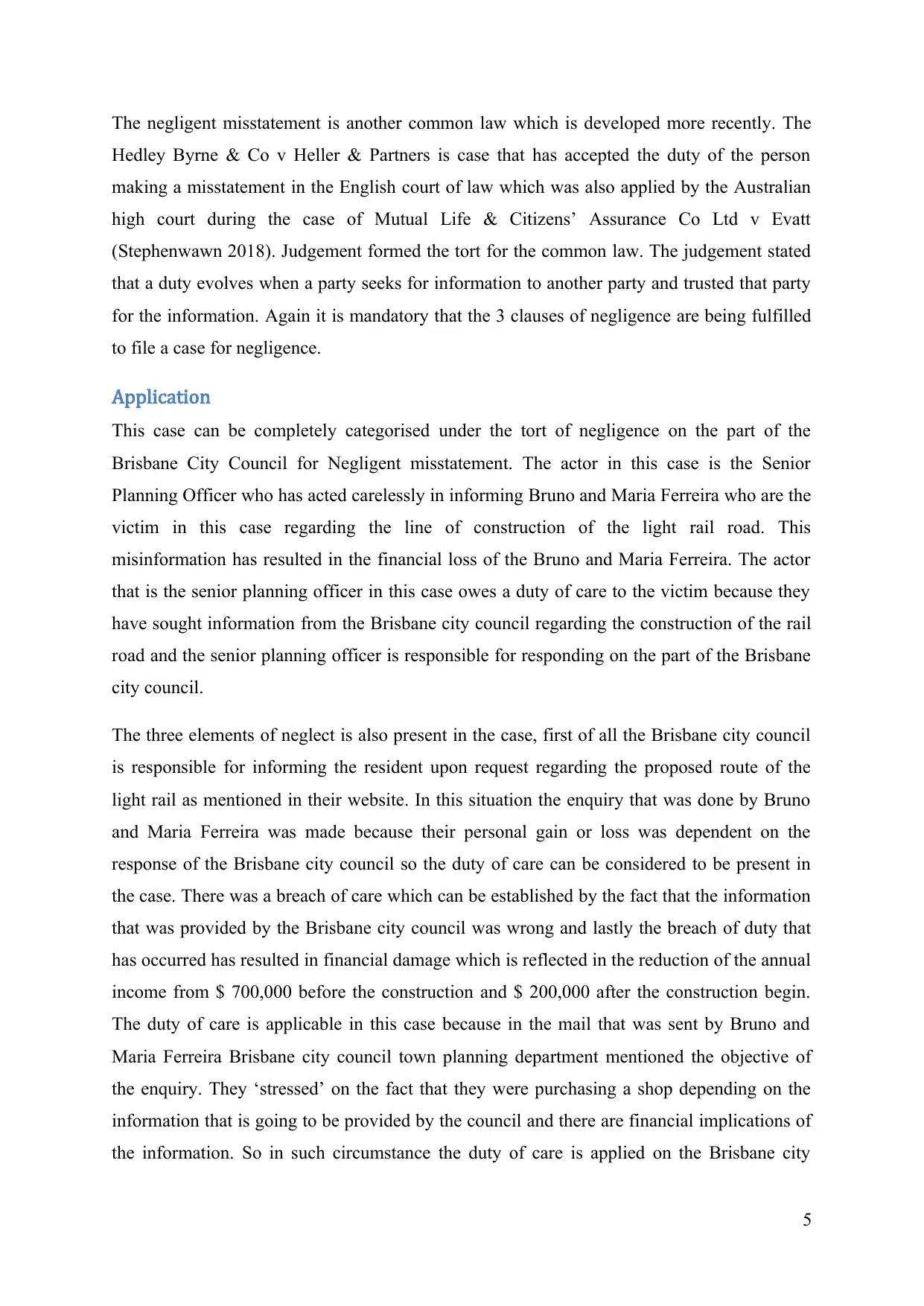
The negligent misstatement is another common law which is developed more recently. The
Hedley Byrne & Co v Heller & Partners is case that has accepted the duty of the person
making a misstatement in the English court of law which was also applied by the Australian
high court during the case of Mutual Life & Citizens’ Assurance Co Ltd v Evatt
(Stephenwawn 2018). Judgement formed the tort for the common law. The judgement stated
that a duty evolves when a party seeks for information to another party and trusted that party
for the information. Again it is mandatory that the 3 clauses of negligence are being fulfilled
to file a case for negligence.
Application
This case can be completely categorised under the tort of negligence on the part of the
Brisbane City Council for Negligent misstatement. The actor in this case is the Senior
Planning Officer who has acted carelessly in informing Bruno and Maria Ferreira who are the
victim in this case regarding the line of construction of the light rail road. This
misinformation has resulted in the financial loss of the Bruno and Maria Ferreira. The actor
that is the senior planning officer in this case owes a duty of care to the victim because they
have sought information from the Brisbane city council regarding the construction of the rail
road and the senior planning officer is responsible for responding on the part of the Brisbane
city council.
The three elements of neglect is also present in the case, first of all the Brisbane city council
is responsible for informing the resident upon request regarding the proposed route of the
light rail as mentioned in their website. In this situation the enquiry that was done by Bruno
and Maria Ferreira was made because their personal gain or loss was dependent on the
response of the Brisbane city council so the duty of care can be considered to be present in
the case. There was a breach of care which can be established by the fact that the information
that was provided by the Brisbane city council was wrong and lastly the breach of duty that
has occurred has resulted in financial damage which is reflected in the reduction of the annual
income from $ 700,000 before the construction and $ 200,000 after the construction begin.
The duty of care is applicable in this case because in the mail that was sent by Bruno and
Maria Ferreira Brisbane city council town planning department mentioned the objective of
the enquiry. They ‘stressed’ on the fact that they were purchasing a shop depending on the
information that is going to be provided by the council and there are financial implications of
the information. So in such circumstance the duty of care is applied on the Brisbane city
5
Hedley Byrne & Co v Heller & Partners is case that has accepted the duty of the person
making a misstatement in the English court of law which was also applied by the Australian
high court during the case of Mutual Life & Citizens’ Assurance Co Ltd v Evatt
(Stephenwawn 2018). Judgement formed the tort for the common law. The judgement stated
that a duty evolves when a party seeks for information to another party and trusted that party
for the information. Again it is mandatory that the 3 clauses of negligence are being fulfilled
to file a case for negligence.
Application
This case can be completely categorised under the tort of negligence on the part of the
Brisbane City Council for Negligent misstatement. The actor in this case is the Senior
Planning Officer who has acted carelessly in informing Bruno and Maria Ferreira who are the
victim in this case regarding the line of construction of the light rail road. This
misinformation has resulted in the financial loss of the Bruno and Maria Ferreira. The actor
that is the senior planning officer in this case owes a duty of care to the victim because they
have sought information from the Brisbane city council regarding the construction of the rail
road and the senior planning officer is responsible for responding on the part of the Brisbane
city council.
The three elements of neglect is also present in the case, first of all the Brisbane city council
is responsible for informing the resident upon request regarding the proposed route of the
light rail as mentioned in their website. In this situation the enquiry that was done by Bruno
and Maria Ferreira was made because their personal gain or loss was dependent on the
response of the Brisbane city council so the duty of care can be considered to be present in
the case. There was a breach of care which can be established by the fact that the information
that was provided by the Brisbane city council was wrong and lastly the breach of duty that
has occurred has resulted in financial damage which is reflected in the reduction of the annual
income from $ 700,000 before the construction and $ 200,000 after the construction begin.
The duty of care is applicable in this case because in the mail that was sent by Bruno and
Maria Ferreira Brisbane city council town planning department mentioned the objective of
the enquiry. They ‘stressed’ on the fact that they were purchasing a shop depending on the
information that is going to be provided by the council and there are financial implications of
the information. So in such circumstance the duty of care is applied on the Brisbane city
5
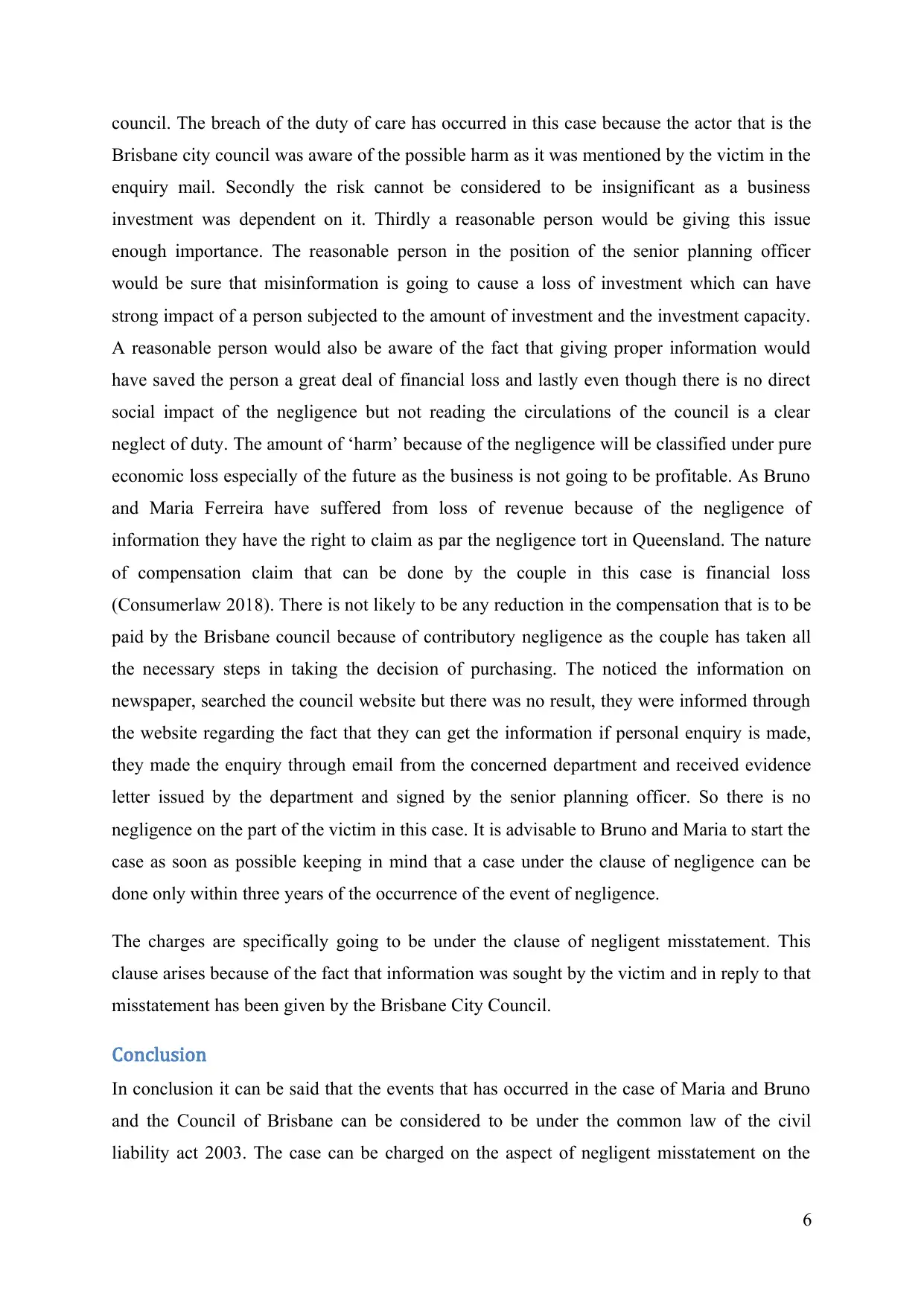
council. The breach of the duty of care has occurred in this case because the actor that is the
Brisbane city council was aware of the possible harm as it was mentioned by the victim in the
enquiry mail. Secondly the risk cannot be considered to be insignificant as a business
investment was dependent on it. Thirdly a reasonable person would be giving this issue
enough importance. The reasonable person in the position of the senior planning officer
would be sure that misinformation is going to cause a loss of investment which can have
strong impact of a person subjected to the amount of investment and the investment capacity.
A reasonable person would also be aware of the fact that giving proper information would
have saved the person a great deal of financial loss and lastly even though there is no direct
social impact of the negligence but not reading the circulations of the council is a clear
neglect of duty. The amount of ‘harm’ because of the negligence will be classified under pure
economic loss especially of the future as the business is not going to be profitable. As Bruno
and Maria Ferreira have suffered from loss of revenue because of the negligence of
information they have the right to claim as par the negligence tort in Queensland. The nature
of compensation claim that can be done by the couple in this case is financial loss
(Consumerlaw 2018). There is not likely to be any reduction in the compensation that is to be
paid by the Brisbane council because of contributory negligence as the couple has taken all
the necessary steps in taking the decision of purchasing. The noticed the information on
newspaper, searched the council website but there was no result, they were informed through
the website regarding the fact that they can get the information if personal enquiry is made,
they made the enquiry through email from the concerned department and received evidence
letter issued by the department and signed by the senior planning officer. So there is no
negligence on the part of the victim in this case. It is advisable to Bruno and Maria to start the
case as soon as possible keeping in mind that a case under the clause of negligence can be
done only within three years of the occurrence of the event of negligence.
The charges are specifically going to be under the clause of negligent misstatement. This
clause arises because of the fact that information was sought by the victim and in reply to that
misstatement has been given by the Brisbane City Council.
Conclusion
In conclusion it can be said that the events that has occurred in the case of Maria and Bruno
and the Council of Brisbane can be considered to be under the common law of the civil
liability act 2003. The case can be charged on the aspect of negligent misstatement on the
6
Brisbane city council was aware of the possible harm as it was mentioned by the victim in the
enquiry mail. Secondly the risk cannot be considered to be insignificant as a business
investment was dependent on it. Thirdly a reasonable person would be giving this issue
enough importance. The reasonable person in the position of the senior planning officer
would be sure that misinformation is going to cause a loss of investment which can have
strong impact of a person subjected to the amount of investment and the investment capacity.
A reasonable person would also be aware of the fact that giving proper information would
have saved the person a great deal of financial loss and lastly even though there is no direct
social impact of the negligence but not reading the circulations of the council is a clear
neglect of duty. The amount of ‘harm’ because of the negligence will be classified under pure
economic loss especially of the future as the business is not going to be profitable. As Bruno
and Maria Ferreira have suffered from loss of revenue because of the negligence of
information they have the right to claim as par the negligence tort in Queensland. The nature
of compensation claim that can be done by the couple in this case is financial loss
(Consumerlaw 2018). There is not likely to be any reduction in the compensation that is to be
paid by the Brisbane council because of contributory negligence as the couple has taken all
the necessary steps in taking the decision of purchasing. The noticed the information on
newspaper, searched the council website but there was no result, they were informed through
the website regarding the fact that they can get the information if personal enquiry is made,
they made the enquiry through email from the concerned department and received evidence
letter issued by the department and signed by the senior planning officer. So there is no
negligence on the part of the victim in this case. It is advisable to Bruno and Maria to start the
case as soon as possible keeping in mind that a case under the clause of negligence can be
done only within three years of the occurrence of the event of negligence.
The charges are specifically going to be under the clause of negligent misstatement. This
clause arises because of the fact that information was sought by the victim and in reply to that
misstatement has been given by the Brisbane City Council.
Conclusion
In conclusion it can be said that the events that has occurred in the case of Maria and Bruno
and the Council of Brisbane can be considered to be under the common law of the civil
liability act 2003. The case can be charged on the aspect of negligent misstatement on the
6
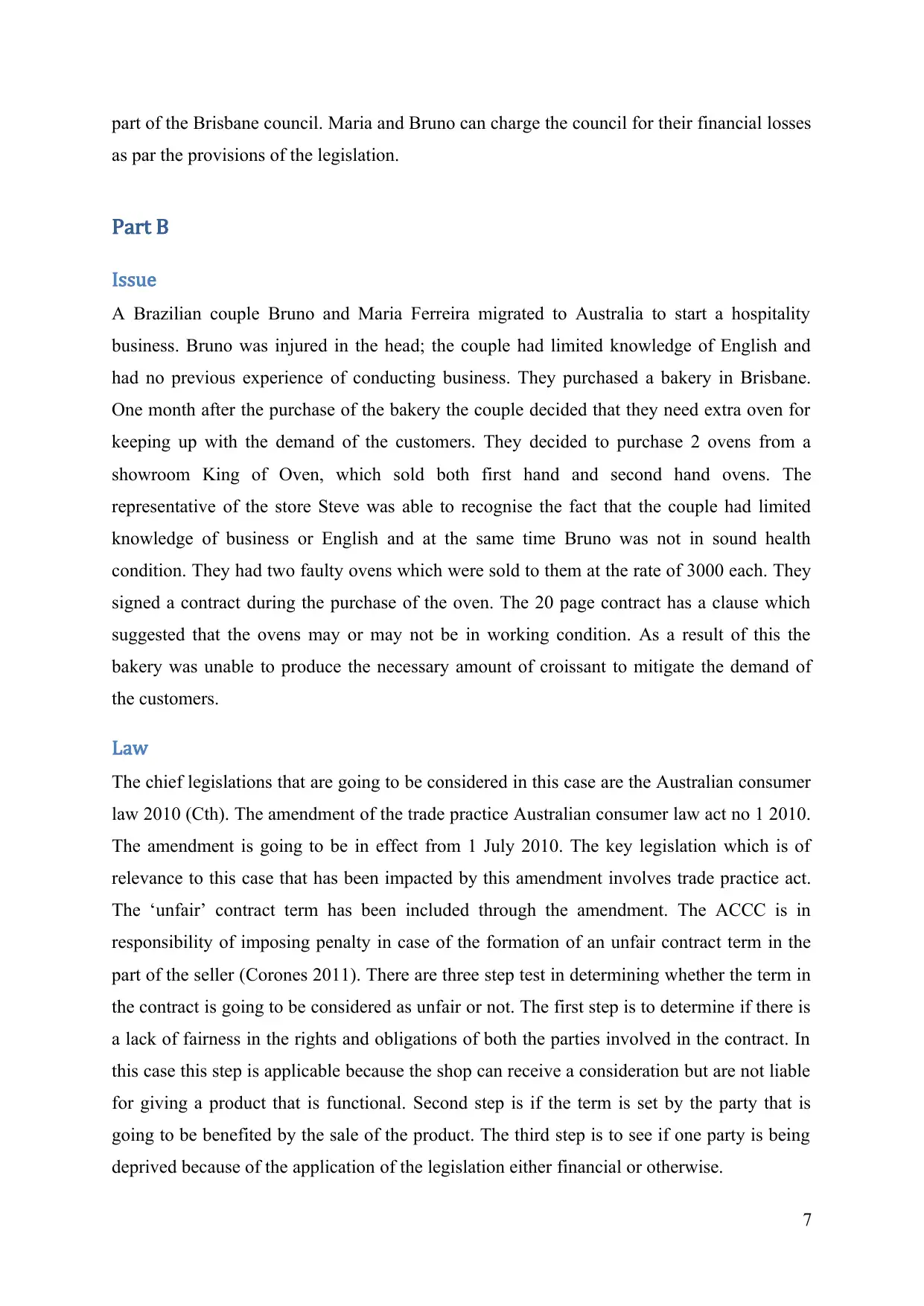
part of the Brisbane council. Maria and Bruno can charge the council for their financial losses
as par the provisions of the legislation.
Part B
Issue
A Brazilian couple Bruno and Maria Ferreira migrated to Australia to start a hospitality
business. Bruno was injured in the head; the couple had limited knowledge of English and
had no previous experience of conducting business. They purchased a bakery in Brisbane.
One month after the purchase of the bakery the couple decided that they need extra oven for
keeping up with the demand of the customers. They decided to purchase 2 ovens from a
showroom King of Oven, which sold both first hand and second hand ovens. The
representative of the store Steve was able to recognise the fact that the couple had limited
knowledge of business or English and at the same time Bruno was not in sound health
condition. They had two faulty ovens which were sold to them at the rate of 3000 each. They
signed a contract during the purchase of the oven. The 20 page contract has a clause which
suggested that the ovens may or may not be in working condition. As a result of this the
bakery was unable to produce the necessary amount of croissant to mitigate the demand of
the customers.
Law
The chief legislations that are going to be considered in this case are the Australian consumer
law 2010 (Cth). The amendment of the trade practice Australian consumer law act no 1 2010.
The amendment is going to be in effect from 1 July 2010. The key legislation which is of
relevance to this case that has been impacted by this amendment involves trade practice act.
The ‘unfair’ contract term has been included through the amendment. The ACCC is in
responsibility of imposing penalty in case of the formation of an unfair contract term in the
part of the seller (Corones 2011). There are three step test in determining whether the term in
the contract is going to be considered as unfair or not. The first step is to determine if there is
a lack of fairness in the rights and obligations of both the parties involved in the contract. In
this case this step is applicable because the shop can receive a consideration but are not liable
for giving a product that is functional. Second step is if the term is set by the party that is
going to be benefited by the sale of the product. The third step is to see if one party is being
deprived because of the application of the legislation either financial or otherwise.
7
as par the provisions of the legislation.
Part B
Issue
A Brazilian couple Bruno and Maria Ferreira migrated to Australia to start a hospitality
business. Bruno was injured in the head; the couple had limited knowledge of English and
had no previous experience of conducting business. They purchased a bakery in Brisbane.
One month after the purchase of the bakery the couple decided that they need extra oven for
keeping up with the demand of the customers. They decided to purchase 2 ovens from a
showroom King of Oven, which sold both first hand and second hand ovens. The
representative of the store Steve was able to recognise the fact that the couple had limited
knowledge of business or English and at the same time Bruno was not in sound health
condition. They had two faulty ovens which were sold to them at the rate of 3000 each. They
signed a contract during the purchase of the oven. The 20 page contract has a clause which
suggested that the ovens may or may not be in working condition. As a result of this the
bakery was unable to produce the necessary amount of croissant to mitigate the demand of
the customers.
Law
The chief legislations that are going to be considered in this case are the Australian consumer
law 2010 (Cth). The amendment of the trade practice Australian consumer law act no 1 2010.
The amendment is going to be in effect from 1 July 2010. The key legislation which is of
relevance to this case that has been impacted by this amendment involves trade practice act.
The ‘unfair’ contract term has been included through the amendment. The ACCC is in
responsibility of imposing penalty in case of the formation of an unfair contract term in the
part of the seller (Corones 2011). There are three step test in determining whether the term in
the contract is going to be considered as unfair or not. The first step is to determine if there is
a lack of fairness in the rights and obligations of both the parties involved in the contract. In
this case this step is applicable because the shop can receive a consideration but are not liable
for giving a product that is functional. Second step is if the term is set by the party that is
going to be benefited by the sale of the product. The third step is to see if one party is being
deprived because of the application of the legislation either financial or otherwise.
7
Paraphrase This Document
Need a fresh take? Get an instant paraphrase of this document with our AI Paraphraser
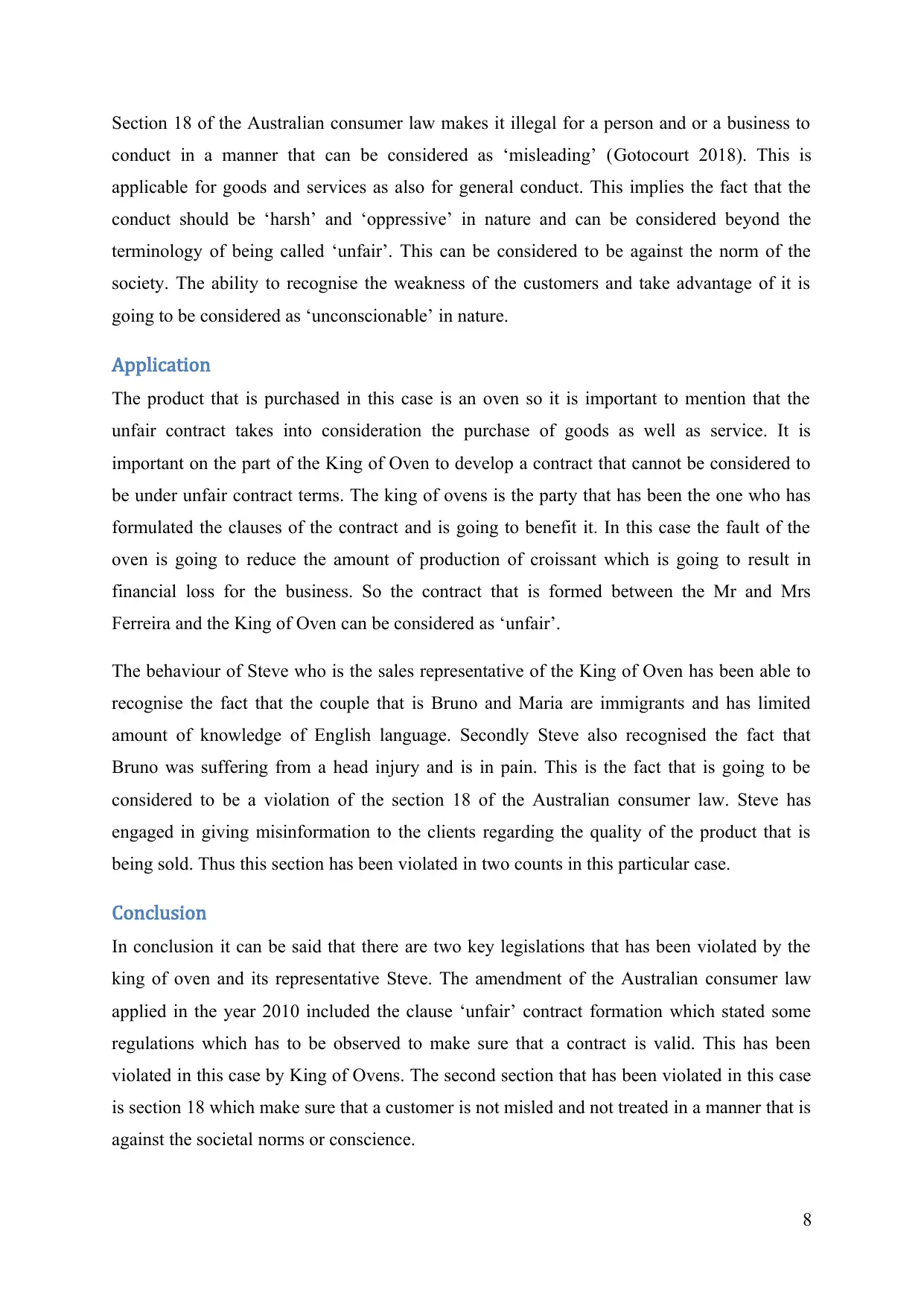
Section 18 of the Australian consumer law makes it illegal for a person and or a business to
conduct in a manner that can be considered as ‘misleading’ (Gotocourt 2018). This is
applicable for goods and services as also for general conduct. This implies the fact that the
conduct should be ‘harsh’ and ‘oppressive’ in nature and can be considered beyond the
terminology of being called ‘unfair’. This can be considered to be against the norm of the
society. The ability to recognise the weakness of the customers and take advantage of it is
going to be considered as ‘unconscionable’ in nature.
Application
The product that is purchased in this case is an oven so it is important to mention that the
unfair contract takes into consideration the purchase of goods as well as service. It is
important on the part of the King of Oven to develop a contract that cannot be considered to
be under unfair contract terms. The king of ovens is the party that has been the one who has
formulated the clauses of the contract and is going to benefit it. In this case the fault of the
oven is going to reduce the amount of production of croissant which is going to result in
financial loss for the business. So the contract that is formed between the Mr and Mrs
Ferreira and the King of Oven can be considered as ‘unfair’.
The behaviour of Steve who is the sales representative of the King of Oven has been able to
recognise the fact that the couple that is Bruno and Maria are immigrants and has limited
amount of knowledge of English language. Secondly Steve also recognised the fact that
Bruno was suffering from a head injury and is in pain. This is the fact that is going to be
considered to be a violation of the section 18 of the Australian consumer law. Steve has
engaged in giving misinformation to the clients regarding the quality of the product that is
being sold. Thus this section has been violated in two counts in this particular case.
Conclusion
In conclusion it can be said that there are two key legislations that has been violated by the
king of oven and its representative Steve. The amendment of the Australian consumer law
applied in the year 2010 included the clause ‘unfair’ contract formation which stated some
regulations which has to be observed to make sure that a contract is valid. This has been
violated in this case by King of Ovens. The second section that has been violated in this case
is section 18 which make sure that a customer is not misled and not treated in a manner that is
against the societal norms or conscience.
8
conduct in a manner that can be considered as ‘misleading’ (Gotocourt 2018). This is
applicable for goods and services as also for general conduct. This implies the fact that the
conduct should be ‘harsh’ and ‘oppressive’ in nature and can be considered beyond the
terminology of being called ‘unfair’. This can be considered to be against the norm of the
society. The ability to recognise the weakness of the customers and take advantage of it is
going to be considered as ‘unconscionable’ in nature.
Application
The product that is purchased in this case is an oven so it is important to mention that the
unfair contract takes into consideration the purchase of goods as well as service. It is
important on the part of the King of Oven to develop a contract that cannot be considered to
be under unfair contract terms. The king of ovens is the party that has been the one who has
formulated the clauses of the contract and is going to benefit it. In this case the fault of the
oven is going to reduce the amount of production of croissant which is going to result in
financial loss for the business. So the contract that is formed between the Mr and Mrs
Ferreira and the King of Oven can be considered as ‘unfair’.
The behaviour of Steve who is the sales representative of the King of Oven has been able to
recognise the fact that the couple that is Bruno and Maria are immigrants and has limited
amount of knowledge of English language. Secondly Steve also recognised the fact that
Bruno was suffering from a head injury and is in pain. This is the fact that is going to be
considered to be a violation of the section 18 of the Australian consumer law. Steve has
engaged in giving misinformation to the clients regarding the quality of the product that is
being sold. Thus this section has been violated in two counts in this particular case.
Conclusion
In conclusion it can be said that there are two key legislations that has been violated by the
king of oven and its representative Steve. The amendment of the Australian consumer law
applied in the year 2010 included the clause ‘unfair’ contract formation which stated some
regulations which has to be observed to make sure that a contract is valid. This has been
violated in this case by King of Ovens. The second section that has been violated in this case
is section 18 which make sure that a customer is not misled and not treated in a manner that is
against the societal norms or conscience.
8

9

Reference List
Consumerlaw (2018). Legislation – Australian Consumer Law. [online]
Consumerlaw.gov.au. Available at:
http://consumerlaw.gov.au/the-australian-consumer-law/legislation/ [Accessed 13 Sep. 2018].
Corones, S.G., 2011. The Australian consumer law. Thomson Reuters Lawbook Co.
Gotocourt (2018). What is Negligence in Queensland under the Civil Liability Act?. [online]
Gotocourt.com.au. Available at:
https://www.gotocourt.com.au/personal-injury/qld/negligence/ [Accessed 13 Sep. 2018].
Huang, S.J. and McLean, A.S., 2010. Do we need a critical care ultrasound certification
program? Implications from an Australian medical-legal perspective. Critical Care, 14(3),
p.313.
Ransley, J., Anderson, J. and Prenzler, T., 2007. Civil litigation against police in Australia:
Exploring its extent, nature and implications for accountability. Australian & New Zealand
journal of criminology, 40(2), pp.143-160.
Stephenwawn (2018). [online] Available at: http://www.stephenwawn.com.au/commercial-
law-litigation-disputes/pure-economic-loss-caused-by-negligent-misstatement-and-the-duty-
of-care 2018The [Accessed 14 Sep. 2018].
10
Consumerlaw (2018). Legislation – Australian Consumer Law. [online]
Consumerlaw.gov.au. Available at:
http://consumerlaw.gov.au/the-australian-consumer-law/legislation/ [Accessed 13 Sep. 2018].
Corones, S.G., 2011. The Australian consumer law. Thomson Reuters Lawbook Co.
Gotocourt (2018). What is Negligence in Queensland under the Civil Liability Act?. [online]
Gotocourt.com.au. Available at:
https://www.gotocourt.com.au/personal-injury/qld/negligence/ [Accessed 13 Sep. 2018].
Huang, S.J. and McLean, A.S., 2010. Do we need a critical care ultrasound certification
program? Implications from an Australian medical-legal perspective. Critical Care, 14(3),
p.313.
Ransley, J., Anderson, J. and Prenzler, T., 2007. Civil litigation against police in Australia:
Exploring its extent, nature and implications for accountability. Australian & New Zealand
journal of criminology, 40(2), pp.143-160.
Stephenwawn (2018). [online] Available at: http://www.stephenwawn.com.au/commercial-
law-litigation-disputes/pure-economic-loss-caused-by-negligent-misstatement-and-the-duty-
of-care 2018The [Accessed 14 Sep. 2018].
10
1 out of 10
Your All-in-One AI-Powered Toolkit for Academic Success.
+13062052269
info@desklib.com
Available 24*7 on WhatsApp / Email
![[object Object]](/_next/static/media/star-bottom.7253800d.svg)
Unlock your academic potential
© 2024 | Zucol Services PVT LTD | All rights reserved.

